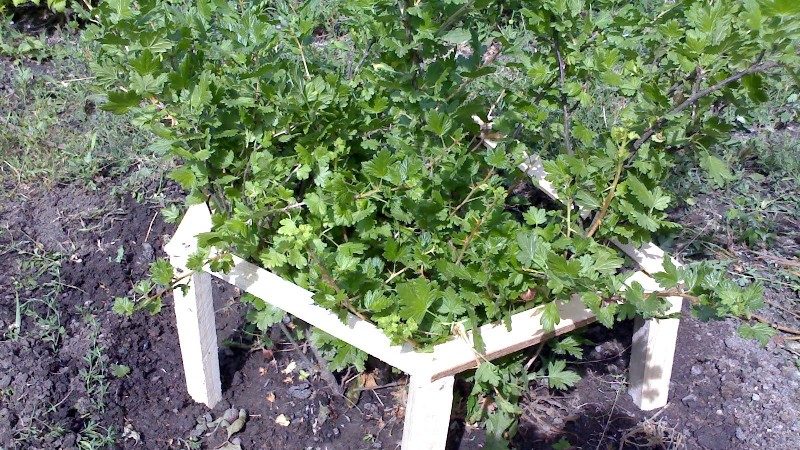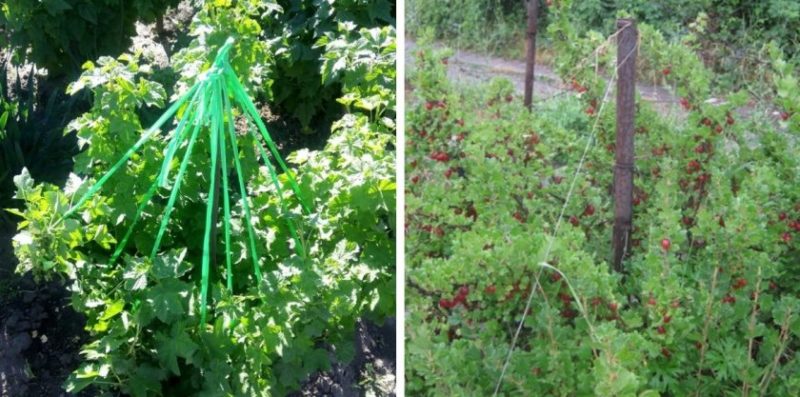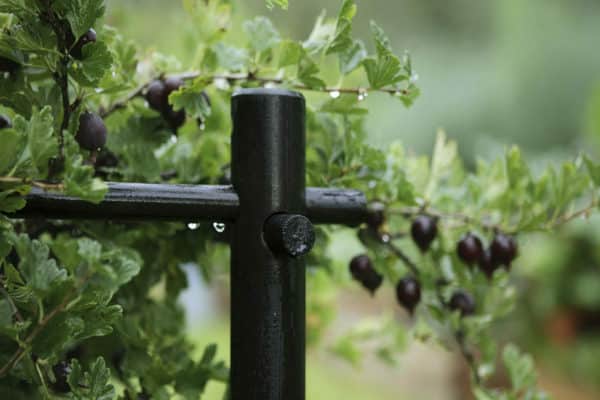Step-by-step instructions for beginner gardeners: how to tie up gooseberries and form a bush correctly
Gooseberry is a popular shrub that is found in most garden plots in Russia. The plant is easy to care for, but it also requires basic care, including a garter. This procedure helps the bush stay healthy and strong. Let's look at how to tie up a gooseberry depending on its desired shape.
Why tie up gooseberries?

Gooseberry is a shrub that, as it grows, forms a large number of branches scattered in all directions. With a good harvest and during heavy rainfall, branches often end up on the ground. This leads to fruit contamination, rotting, and spoilage by worms and insects. Branches that do not have a support point often break and become infected with fungi.
Gooseberry branches are tied not only for practical benefit, but also to give it a beautiful shape and a neat appearance. A garter is the only way to “curb” the wild branches of a thorny bush.
Is this necessary?
25% of amateur gardeners neglect the gooseberry garter, considering it optional. This leads to damage to the branches during winds or after the accumulation of wet snow. The plant becomes sick more often, and fruits on branches bent to the ground become unsuitable for consumption.
Gartering gooseberries is a mandatory step in caring for them. Neglecting care means exposing the shrub to an increased risk of disease or even death.
Timing of the garter

Gooseberries are tied up from the first years of its life. It is recommended to install the support immediately when planting the plant - this will help begin the formation of the bush and reduce work in the future.
Gooseberries are tied up in the same season when the branches are pruned - in spring or autumn. In summer, the bush should not be touched, since pruning or tying during active berry growth can cause irreparable harm.
When is it better to tie - in spring or autumn?
The best time of year for gooseberry garter is spring. However, there are some nuances here. The shrub quickly recovers from winter sleep and is one of the first to wake up in the garden plot.
Advice! It is important not to miss the moment and tie up the plant before the buds form and the leaves bloom.
If the moment of spring garter is missed, you should not touch the already awakened plant. It is advisable to wait until autumn and tie up the bush in late September - early October.
Garter methods
The method of gartering depends on the desired shape of the bush. Each method has its pros and cons, but they are united by common goals: to prevent damage to plants, infection with fungal and infectious diseases, and contamination of berries.
There are 3 main methods of garter:
- classical;
- standard;
- on the trellis.
To choose the appropriate method, gardeners determine how much space on the site can be given to gooseberries and what shape the bush will take. Additionally, the characteristics of the variety are taken into account. There are plants that climb along a support, and there are those that more closely resemble a tree.
Classic on the fence
The classic method is to form a gooseberry bush with a fence around it. The method is popular and easy to implement. For gartering, support is placed around the bush. They form a circle, a triangle, a square - any shape that depends on the desire and imagination of the gardener.Classic fencing is available in specialized stores, but they are also made from scrap materials.
Made of wood

The fence is made from any pieces of wood available in the garden. The construction of the fence itself does not take much time and does not cause difficulties.
Important! Wood is a material prone to deterioration under the influence of precipitation and insects. Therefore, before making the fence, all slats are treated with an antiseptic, painted and varnished.
3–5 wooden stakes of equal length are driven around the bush. A railing is formed from the slats on top and secured to the stakes with nails or self-tapping screws. The height of the fence is adjusted depending on the maximum height of the bush, the width - on the desired volume of the plant.
From reinforcement
A fence made of reinforcement is constructed in a similar way - posts and railings at a height of 1/3 of the maximum size of the bush. To cut the reinforcement and connect the parts you will need a grinder and a welding machine.
The reinforcement is cut into pieces of suitable length, taking into account that 20–30 cm will be in the ground. The resulting columns are driven into the soil around the bush. The distance between the pillars is about 25 cm. A railing made of the same material is welded on top. Such a structure will help to firmly hold the gooseberry branches. The reinforcement is made from wear-resistant materials, so the fence will last a long time.
From plastic pipes
The support is made in the same way as wood and reinforcement. Cuttings of PVC pipes are installed around the bush at a distance of 20–25 cm. A railing is formed on top.
Plastic is not the most durable material. Pipes are deformed under the influence of low and high temperatures, and crack during winter frosts. Therefore, the supports will have to be removed for the winter and reinstalled in the spring.
Stambova

The standard method helps to grow gooseberries not in the form of a bush, but resembling a tree. To do this, one strong shoot is selected from the branches, the rest are removed. A support 1 m high is placed in the ground nearby (higher is possible, but it is inconvenient to harvest from a taller tree). The future tree trunk is tied to a support, all side branches are removed from it, only the top ones (4-5 pieces) are left.
With the standard method, it is important to trim the branches in a timely manner. All root shoots are removed immediately, as are the lateral shoots. The branches at the top of the tree are shortened annually to 20 cm. To avoid constantly having to cut off the side shoots, an opaque rubber tube is placed on the trunk.
On the trellis
Growing gooseberries on a trellis is the most rational way to form a bush, especially if you have several plants or entire plantations.
For gartering, supports are installed on both sides of the row of bushes. Wire is pulled over them (3-4 horizontal rows with a gap of 20 cm between them). When forming a simple trellis, the bush is pruned, leaving only the 3 strongest shoots. They are tied to a wire of suitable height: directed upward, but at the same time distributed at a distance from each other (sufficient so that the branches do not interfere with neighbors).
Important! Before the winter cold, it is recommended to remove gooseberry shoots from the trellis and insulate them. Otherwise, there is a high risk that the branches will freeze.
In addition to a simple trellis, a double trellis is built on the site. In this case, 2-3 horizontal crossbars 50–60 cm long are placed on supports installed on both sides of the row. Wire is pulled along the edges of the crossbars. They tie up the shoots in the same way as on a simple trellis, only they leave not 3 on each bush, but 6.

How to secure branches

Experienced gardeners use jute twine to secure the branches to the support, which is renewed annually. It is undesirable to use fishing line (thin material cuts the bark) and wire (if you do not renew it, it will grow into the shoot).
When securing the branches to the support, it is important not to overtighten them - too tight a garter harms the plant. At the same time, a loop that is too loose will also not be beneficial.
How to make them strong
It is important for tied gooseberry branches to remain strong and flexible, otherwise during the formation of the bush or harvest they will break from mechanical stress. Annual care makes the shoots strong: timely pruning, fertilizing soil, watering, treatment from pests.
Pruning is best done in the spring, before the plant awakens. Remove all damaged branches and young shoots that do not bear fruit, and thin out the bush. Wounds formed during pruning are treated with garden varnish.
Feed the bushes in the fall. To do this, use compost (2/3 of a bucket per plant) or mineral fertilizer containing nitrogen, phosphorus and potassium.
How to form a bush correctly

The formation of gooseberries largely depends on the method of gartering. With the classic method, it is important to prune the plant correctly. The branches should not form a dense crown; air circulation and access to sunlight to each branch are important for the crop. An adult plant leaves no more than 20 strong shoots of different ages, a 1-2 year old bush - no more than 6, a 3-4 year old bush - no more than 15. The edges of last year's branches are shortened by 1/3.
With the standard method, only one trunk of the gooseberry is left, all other basal shoots are removed. The side branches are removed, leaving only the top ones, at the height of the trunk (usually 1 m).
When tied to a trellis, the shape of the bush is similar to the classic one. The edges of last year's shoots are shortened by 1/3, of the young branches formed in the year of pruning, no more than 4 are left. Old and damaged ones are removed.
How to tie up gooseberries so that the branches are not on the ground

Tying is an important step in caring for the crop. Neglecting it leads to plant diseases and branches breaking under the weight of the harvest. Berries on the ground become contaminated and spoiled by animals and insects.
How to tie up a bush so that the branches do not lie on the ground:
- choose a growing method (classical, trellis, standard);
- based on the characteristics varieties, determine the height of the bush and the desired width;
- make or buy a support suitable in size to the future height of the plant;
- install support and tie up shoots.
The branches of a properly formed bush do not touch the ground. This helps protect it from damage, dirt and insects.
This is interesting:
Sweet and juicy gooseberry variety Yubilyar
The sweetest and largest gooseberry: description of varieties
Conclusion
Gooseberries are a crop that definitely needs staking. The branches attached to the support are protected from damage, the plant has a reduced risk of becoming infected with fungal diseases, and is less susceptible to attack by ground insects. A tied bush takes up less space on the site and looks neat, and harvesting is less hassle.